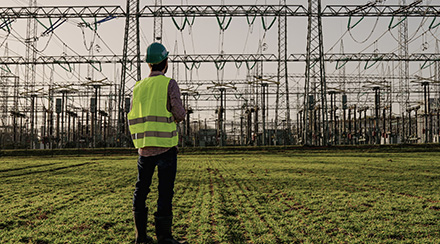What Is Energy Deregulation?

If you moved to a different state at some point in the last few decades, there’s a chance you experienced a big change in the way you purchase energy. That’s because the U.S. is now a state-by-state patchwork in which energy is “regulated” or “deregulated.” Energy deregulation is a growing trend, and it’s one that is giving more consumers greater choice in where they buy electricity and natural gas.
What Is Energy Deregulation?
Energy deregulation refers to the process of structuring an energy market so that consumers can buy energy from “suppliers” instead of directly from energy utilities, creating more competition in the market. In a deregulated energy market, the utilities continue to deliver the energy and maintain the poles and wires involved while the suppliers buy energy credits and sell them to their customers.
This allows energy suppliers to compete for business by offering competitive rates, flexible terms, enrollment incentives and other perks that benefit consumers. Consumers can then browse the marketplace for the supplier or energy plan that best matches their needs, budget and values.
How the Deregulation of Energy Happened
When Thomas Edison opened the nation’s first commercial power plant in Manhattan in 1882, there were no regulations governing the delivery of energy. It would remain that way for years, as electricity was a rare luxury available to only the wealthiest Americans.
Eventually, the growing availability of and dependence on electricity pushed Congress to regulate the industry with the passage of the Public Utilities Holding Company Act (PUHCA) in 1935. Congress created a more complex regulatory structure in 1965 with the creation of the North American Electric Reliability Council (NERC), which succeeded in making the electricity grid more reliable, but also contributed to the formation of powerful energy monopolies.
Congress intervened again in 1978, at the height of the 1970s energy crisis, but this marked the federal government’s first move toward deregulation. With the passage of the Public Utility Regulatory Policies Act of 1978 (PURPA), the government sought to diversify the energy industry, encourage competition and incentivize the development of renewable energy technologies.
Finally, in 1992, the Energy Policy Act was passed, allowing states to more fully capitalize on the potential of energy deregulation and open energy marketplaces up to competition. California became the first state to deregulate its electricity market in 1996, and more than two dozen states would do the same in the years to follow.
Not all states have taken advantage of energy deregulation. Refer to this map for up-to-date information on states with deregulated energy. Among states with deregulated energy markets, some have only deregulated electricity, some have only deregulated natural gas, and some have deregulated both.
How Does Shopping Work in States with Deregulated Energy?

Among the states that have deregulated one or more of their energy markets, you’ll find varying approaches to how a customer shops for energy service. In many states, the local utility still competes for customers in the marketplace along with suppliers. In others, the utility is only responsible for delivering energy and customers must choose a supplier.
The state agencies that oversee energy production and delivery typically provide a number of ways for customers to browse and compare plans, the most user-friendly of which is an online marketplace.
When shopping for plans, you’ll find that energy suppliers compete in multiple ways. Some suppliers emphasize their low rates. Others promote their customer service ratings. Some compete for ecologically conscious consumers by investing in things like renewable energy technology or carbon capturing.
Suppliers may also offer a variety of rate structures that can potentially help you save money. These can include fixed-rate plans for customers who want predictability and plans with special pricing features, such as free electricity on weekends. Some suppliers even attract customers with incentives like gift cards, electronics or tickets to special events.
In many cases, especially with fixed-rate plans, you’ll be required to sign a contract. Contract terms may last anywhere from six months to two years. You can break your contract if you move to a new address that is outside the service area of your supplier, but if you want to end your contract early for any other reason, there may be a penalty.
What Else Is Different Under Energy Deregulation?
If you get your energy plan from a supplier, you’ll have relationships with two companies: the energy supplier that you choose, and the energy utility that is assigned to your area.
Because of that difference, you’ll need to contact different companies depending on what kind of help you need. If you’re experiencing a power outage, have damage to your electric meter or need to report an energy emergency like downed power lines or a natural gas leak, you’ll want to contact your energy utility.
Payment and billing work differently depending on your state. In some states, your supplier bills you while in others, the bill comes from your utility.
If you want to change your plan or transfer your service, you should contact your energy supplier.
If you live in a state that is considering a switch to energy deregulation, there’s no need to worry about your utilities – they’re not going anywhere. Their most vital services – the generation, transmission and delivery of energy – are considered a natural monopoly. But if your state decides that the retail side of the energy business is ripe for competition, it may open up a whole new marketplace where you’ll have greater control over how you power your home.
Looking for Something Specific?
Select a category to find resources for topics that interest you.
Select Category

Related Articles:

How to Read Your Energy Bill
When’s the last time you really looked at your energy bill? If you ever want to know exactly where your money is going – or if you might be able to save on energy costs – you should spend a few minutes taking a deep dive into your latest energy bills.
Read Article
What’s the Difference Between Utilities and Suppliers?
In a competitive energy market, suppliers can compete with each other and often the utility for customers. Learn the differences between utilities and suppliers and the parts that both play in getting energy to your home.
Read Article
What Are the Benefits of a Retail Energy Supplier?
If you live in a state with a competitive energy market, you probably have your choice of several suppliers that are competing to win your business. Learn why signing up with one of these suppliers could benefit you.
Read ArticleMost Popular Articles

Energy Plans to Fit Your Lifestyle
NRG offers electricity and natural gas plans with perks like cash back, travel rewards and more, so you can find a plan that fits your home and family.
What Is Energy Deregulation?
If you moved to a different state at some point in the last few decades, there’s a chance you experienced a big change in the way you purchase energy. That’s because the U.S. is now a state-by-state patchwork in which energy is “regulated” or “deregulated.” Energy deregulation is a growing trend, and it’s one that is giving more consumers greater choice in where they buy electricity and natural gas.
What Is Energy Deregulation?
Energy deregulation refers to the process of structuring an energy market so that consumers can buy energy from “suppliers” instead of directly from energy utilities, creating more competition in the market. In a deregulated energy market, the utilities continue to deliver the energy and maintain the poles and wires involved while the suppliers buy energy credits and sell them to their customers.
This allows energy suppliers to compete for business by offering competitive rates, flexible terms, enrollment incentives and other perks that benefit consumers. Consumers can then browse the marketplace for the supplier or energy plan that best matches their needs, budget and values.
How the Deregulation of Energy Happened
When Thomas Edison opened the nation’s first commercial power plant in Manhattan in 1882, there were no regulations governing the delivery of energy. It would remain that way for years, as electricity was a rare luxury available to only the wealthiest Americans.
Eventually, the growing availability of and dependence on electricity pushed Congress to regulate the industry with the passage of the Public Utilities Holding Company Act (PUHCA) in 1935. Congress created a more complex regulatory structure in 1965 with the creation of the North American Electric Reliability Council (NERC), which succeeded in making the electricity grid more reliable, but also contributed to the formation of powerful energy monopolies.
Congress intervened again in 1978, at the height of the 1970s energy crisis, but this marked the federal government’s first move toward deregulation. With the passage of the Public Utility Regulatory Policies Act of 1978 (PURPA), the government sought to diversify the energy industry, encourage competition and incentivize the development of renewable energy technologies.
Finally, in 1992, the Energy Policy Act was passed, allowing states to more fully capitalize on the potential of energy deregulation and open energy marketplaces up to competition. California became the first state to deregulate its electricity market in 1996, and more than two dozen states would do the same in the years to follow.
Not all states have taken advantage of energy deregulation. Refer to this map for up-to-date information on states with deregulated energy. Among states with deregulated energy markets, some have only deregulated electricity, some have only deregulated natural gas, and some have deregulated both.
How Does Shopping Work in States with Deregulated Energy?
Among the states that have deregulated one or more of their energy markets, you’ll find varying approaches to how a customer shops for energy service. In many states, the local utility still competes for customers in the marketplace along with suppliers. In others, the utility is only responsible for delivering energy and customers must choose a supplier.
The state agencies that oversee energy production and delivery typically provide a number of ways for customers to browse and compare plans, the most user-friendly of which is an online marketplace.
When shopping for plans, you’ll find that energy suppliers compete in multiple ways. Some suppliers emphasize their low rates. Others promote their customer service ratings. Some compete for ecologically conscious consumers by investing in things like renewable energy technology or carbon capturing.
Suppliers may also offer a variety of rate structures that can potentially help you save money. These can include fixed-rate plans for customers who want predictability and plans with special pricing features, such as free electricity on weekends. Some suppliers even attract customers with incentives like gift cards, electronics or tickets to special events.
In many cases, especially with fixed-rate plans, you’ll be required to sign a contract. Contract terms may last anywhere from six months to two years. You can break your contract if you move to a new address that is outside the service area of your supplier, but if you want to end your contract early for any other reason, there may be a penalty.
What Else Is Different Under Energy Deregulation?
If you get your energy plan from a supplier, you’ll have relationships with two companies: the energy supplier that you choose, and the energy utility that is assigned to your area.
Because of that difference, you’ll need to contact different companies depending on what kind of help you need. If you’re experiencing a power outage, have damage to your electric meter or need to report an energy emergency like downed power lines or a natural gas leak, you’ll want to contact your energy utility.
Payment and billing work differently depending on your state. In some states, your supplier bills you while in others, the bill comes from your utility.
If you want to change your plan or transfer your service, you should contact your energy supplier.
If you live in a state that is considering a switch to energy deregulation, there’s no need to worry about your utilities – they’re not going anywhere. Their most vital services – the generation, transmission and delivery of energy – are considered a natural monopoly. But if your state decides that the retail side of the energy business is ripe for competition, it may open up a whole new marketplace where you’ll have greater control over how you power your home.
Looking for Something Specific?
Select a category to find resources for topics that interest you.
Select Category

Related Articles:

How to Read Your Energy Bill
When’s the last time you really looked at your energy bill? If you ever want to know exactly where your money is going – or if you might be able to save on energy costs – you should spend a few minutes taking a deep dive into your latest energy bills.
Read Article
What’s the Difference Between Utilities and Suppliers?
In a competitive energy market, suppliers can compete with each other and often the utility for customers. Learn the differences between utilities and suppliers and the parts that both play in getting energy to your home.
Read Article
What Are the Benefits of a Retail Energy Supplier?
If you live in a state with a competitive energy market, you probably have your choice of several suppliers that are competing to win your business. Learn why signing up with one of these suppliers could benefit you.
Read ArticleMost Popular Articles

Energy Plans to Fit Your Lifestyle
NRG offers electricity and natural gas plans with perks like cash back, travel rewards and more, so you can find a plan that fits your home and family.







